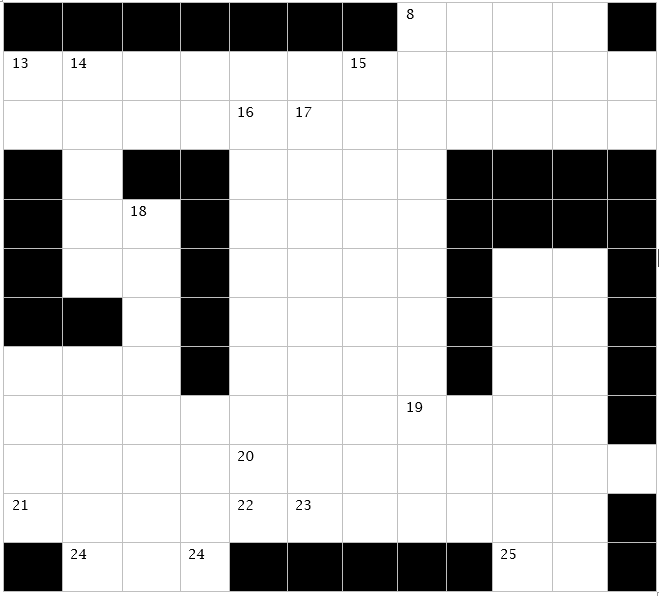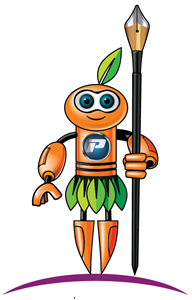Brainy Bits

Clues: Level 1
HORIZONTAL
8. Have to wrap up before the holiday, please ____ accordingly.(4)
13. Pay digitally if you don’t have this. (4)
14. Very pale, “as+hen” (5)
15. A scientifically ____ fact (6)
16. A body part….ends with high (5) ←
17. A flowchart explains this well. (7)
19. The ____ element in XML or HTML (4)←
20. Technical writing tool or a help from robot (8)
21. Working together, starts from the first part of “collage.” (11)
VERTICAL
8. An asset or a possession (8)
14. A software development methodology (5)
15. JD: Ability to take ownership of the _____ (7)
18. Able to be read (8)
22. Expressing oneself clearly, an art starts with “art” (10) ↑
23. Do it where you stop reading (8) ↑
24. Don’t judge a book by this (5) ↑
25. Remove the “L” from, and do it to be “literate” (7) ↑
Cryptic Clues
HORIZONTAL
8. A or B? Good to have a back up! (4)
13. Sounds like computer memory.. always ready in your wallet.
14. The ornament of an Indian yogi, maybe, adds a fowl for sacrifice.” looks pale indeed”!! (5)
15. The oven with a PR to start with! Needs no evidence!(6)
16. Elephant pants will cuddle this in comfort!! A “high T“ jumbled with Pad Thai! (5)←
17. Extra tax at the end!! Begin like a Pro! (7)
19. The Markup tree delves deep with this(4) ←
20. No writer’s block this! Hero help! RA-ONE?(8)
21. Team up …labor to elaborate(11)
VERTICAL
16. It may be proper to have tea at the end and make it an asset! (8)
15. No waterfall ahead ! Let’s quickly make changes midway! (5)
18. Doctor’s prescription is usually not this?
22. “Friends Romans Countrymen….” This was Mark Antony’s art. Can you thus…..? (10) ↑
23. Like a comma midway I nestle in your texts!! Mark my words I leave no mark! (8)↑
24. A façade may be deceptive even for books? Dash for it if it pours or caught in firing (5)↑.
25. Perform repeatedly. Stress in a way. Something missing in literate! (7) ↑
HORIZONTALLY
8. PLAN
13. CASH
14. ASHEN
15. PROVEN
16. THIGH
17. PROCESS
19. ROOT
20. ROBOHELP
21. COLLABORATE
VERTICALLY
8. PROPERTY
14. AGILE
15. PROJECT
18. READABLE
22. ARTICULATE
23. BOOKMARK
24. COVER
25. ITERATE
- B. Internet of Behaviors (IoB)
- A. STEP (Standard for the Exchange of Product Data)
- A. Property Sheet
- A. Imperative Mood
- C. Pair Writing
- B. Sprint Retrospective
- C. Run-on sentence or comma splice
- A. CTRL+SHIFT+V
- B. Ann Handley
- C. Content Brief
What emerging trend connects technologies that combine individual data like facial recognition and location and associates them to human behavior?
A. Internet of Things
B. Internet of Behaviors (IoB)
C. Internet of Processes
What type of file can hold three-dimensional (3D) data in a format that can be recognized by multiple programs?
A. STEP (Standard for the Exchange of Product Data)
B. JPEG ( Joint Photographic Expert Group)
C. EPS ( Encapsulated PostScript)
What do you call a dialog box that displays information about an object and its properties?
A. Property Sheet
B. Pop-up
C. Display box
In technical writing, what mood expresses a command or makes a request by omitting the subject of the sentence?
A. Imperative Mood
B. Subjunctive Mood
C. Superlative Mode.
What is the method of getting immediate feedback on factual accuracy by developing content along with a subject matter expert?
A. Live reviews
B. Parallel Writing
C. Pair Writing
In Agile, what is the meeting where what went well and what did not go well in a sprint are discussed?
A. Sprint Review
B. Sprint Retrospective
C. Sprint Appreciation
A sentence that incorrectly uses a comma to connect two independent clauses is called a …….
A. Subordinate clause
B. Incomplete sentence
C. Run-on sentence or comma splice
In Madcap Flare, which keyboard shortcut can you use to insert a variable?
A. CTRL+SHIFT+V
B. CTRL+SHIFT+M
C. CTRL+SHIFT+I
Name the author of the book, Everybody Writes: Your Go-To Guide to Creating Ridiculously Good Content.
A. Ian Rand
B. Ann Handley
C. Diana Woods
Which type of document outlines the vision, goals, and objectives of a content experience?
A. Design Document
B. Architecture Document
C. Content Brief
This quick FAQ section helps you know the new trends, technologies, and tools.
Q. What is meant by API?
A. API means Application Programming Interface. API is the programming interface that helps sharing and consuming of data between applications.
Q. How does the API communication work?
A . If there are two applications, A and B, they can communicate using the APIs:
- Application A can REQUEST Application B for accessing some resources.
- Application B can provide a RESPONSE to the request. With a response, the request is either approved or rejected.
- A Resource refers to the data set in an application and is returned as Response.
Q. What are the key types of API?
A . SOAP (Simple Object Access Protocol), REST (REpresentational State Transfer) and Webhook are the popular types of APIs.
- SOAP : Uses only XML for data exchange.
- REST : Uses JSON/XML/text/image for data exchange.
- Webhook : Working over the web, Webhooks are data and executable commands sent from one application to another over HTTP that run when an event occurs.
Q. Does an API require access to the Web?
A . No, not always, access to the web is required only when accessing a web service. Some APIs run within a company’s internal network on internal microservices of the application without needing access to the web.
Q. Are all APIs web services?
A . No. Not all APIs are web services. But all web services are APIs.
Q. Can any application access any resource from another application using an API?
A . Yes and No. If an application does not define access rights, any application can access the resources. But, to avoid threat and also to provide selective access, companies use Authentication and Authorization to allow selective access
Q. What do Authentication and Authorization define?
A . Authentication defines the identity of a requestor and Authorization defines the access level of Application A in Application B.
Q. What is CRUD in API?
A . CRUD is the abbreviation for Create, Read, Update, Delete – the popular action performed by APIs on applications using the Post (create), Get (Read), Put (Update) and Delete (delete) methods.
Q. What is an EndPoint?
A . An EndPoint is a URL that provides an exact description about how to access the resource for which the request is sent. The description contains host URL and parameters.
Q. What are parameters?
A . Parameters are variables used in an endpoint for a resource. Different types of parameters are Query parameters, Path parameters, and Headers.
Q. Does an API fail ever? How does one know about failures?
A . Yes, like everything else, API fails too. To let users know about the failures, Status Codes are defined. Every status code number informs why an API failed. For success, Status Code 200 is displayed.
Q. Does one need programming or coding knowledge to become an API documentation
writer?
A . No, not necessarily. If as a tech writer you can understand a product, you can easily become an API documentation writer. For API documentation, a writer is not required to write code but just needs to read it properly.
The API Documentation course by Tech Writer’s Tribe has trained such 60+ enthusiasts in learning API documentation skills. To know and learn more about API Documentation, refer to the course link.
Read more in Edition 2
Articles
- Domain Knowledge by Ravi Dhumane
- Readability Metrics by Nandini Sridharan
- Multi-tasking by Romi Ganguly
- SWOT Analysis by Mridula Menon
- Parts Catalogue by Andre Streefkerk
- Six Insights by Sunita Vyas
Travel Diaries by Vineeta Pant
- Poem and Painting: Under the Pale Moonlight by Nupur Pattnaik
- Poem: Don’t Wanna Remember by Vishal Gupta
- Hobby: Direct Clicks by Mohan Raghuram

